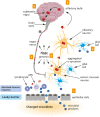Exploring Braak's Hypothesis of Parkinson's Disease
- PMID: 28243222
- PMCID: PMC5304413
- DOI: 10.3389/fneur.2017.00037
Exploring Braak's Hypothesis of Parkinson's Disease
Abstract
Parkinson's disease (PD) is a neurodegenerative disorder for which there is no cure. Most patients suffer from sporadic PD, which is likely caused by a combination of genetic and environmental factors. Braak's hypothesis states that sporadic PD is caused by a pathogen that enters the body via the nasal cavity, and subsequently is swallowed and reaches the gut, initiating Lewy pathology (LP) in the nose and the digestive tract. A staging system describing the spread of LP from the peripheral to the central nervous system was also postulated by the same research group. There has been criticism to Braak's hypothesis, in part because not all patients follow the proposed staging system. Here, we review literature that either supports or criticizes Braak's hypothesis, focused on the enteric route, digestive problems in patients, the spread of LP on a tissue and a cellular level, and the toxicity of the protein αSynuclein (αSyn), which is the major constituent of LP. We conclude that Braak's hypothesis is supported by in vitro, in vivo, and clinical evidence. However, we also conclude that the staging system of Braak only describes a specific subset of patients with young onset and long duration of the disease.
Keywords: Braak’s hypothesis; Lewy pathology; Parkinson’s disease; enteric nervous system; αSynuclein.
Figures

References
Publication types
LinkOut - more resources
Full Text Sources
Other Literature Sources

